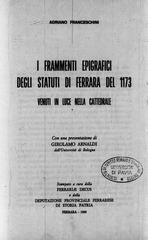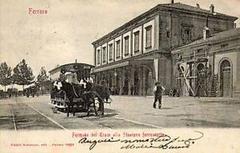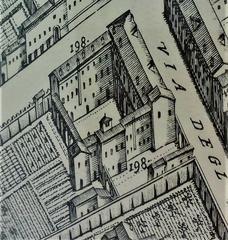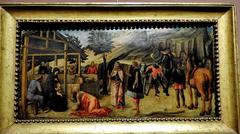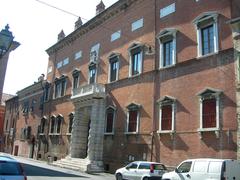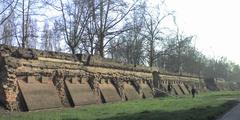Certosa of Ferrara: Visiting Hours, Tickets, and Guide to Historical Sites
Date: 15/06/2025
Introduction
The Certosa of Ferrara, nestled within the city’s historic walls, is one of Italy’s most remarkable Renaissance landmarks. Originally established as a Carthusian monastery in 1452 by Borso d’Este, Duke of Ferrara, it has evolved into the city’s principal monumental cemetery. Today, the Certosa blends religious devotion, artistic achievement, and civic memory, offering a serene and culturally rich destination for visitors. This comprehensive guide details visiting hours, ticket information, accessibility, major historical features, and practical tips to help you make the most of your exploration (Museo Ferrara, Inferrara, Pro Loco Ferrara, Italia.it).
Table of Contents
- History and Cultural Significance
- Architectural Highlights
- Funerary Art and Notable Figures
- Visiting Hours and Tickets
- Getting There and Accessibility
- Guided Tours and Thematic Itineraries
- Visitor Experience and Etiquette
- Nearby Attractions
- Practical Information and FAQ
- Summary and Recommendations
- References and Further Reading
History and Cultural Significance
The Certosa of Ferrara’s origins date back to 1452, when Borso d’Este commissioned the Carthusian monastery, reflecting the Este dynasty’s dedication to faith and culture. Integrated into the innovative Addizione Erculea urban expansion by Biagio Rossetti in the late 15th century, the Certosa became a symbol of Ferrara’s Renaissance transformation. In 1813, following Napoleonic reforms, it was repurposed as the city’s monumental cemetery, preserving its religious and artistic essence while embracing a new civic function (Museo Ferrara, Inferrara).
Architectural Highlights
Tempio di San Cristoforo
The centerpiece of the Certosa is the Church of San Cristoforo, designed by Biagio Rossetti and completed in 1498. Its single nave and six side chapels represent Renaissance ideals of harmony and proportion. The façade and interior are adorned with works by Ferrarese masters, including Ludovico and Agostino Carracci and Bastianino. Notably, the church houses a 15th-century wooden choir originally from Sant’Andrea, a masterpiece of woodcarving that survived WWII and was relocated for preservation (Inferrara).
Cloisters and Porticoes
Behind the church, the grand cloister features delicate columns and a central garden, embodying Carthusian ideals of solitude and contemplation. The 19th-century transformation introduced monumental marble and terracotta porticoes, now framing the cemetery’s solemn entrance and adding architectural grandeur (Museo Ferrara).
Funerary Art and Notable Figures
The Certosa is renowned for its funerary art, which spans from the Renaissance to the 20th century. Sculpted tombs, family chapels, and memorials create an open-air museum of artistic styles—Renaissance, Neoclassical, and Art Nouveau. The site is the final resting place of significant individuals such as film director Michelangelo Antonioni and painter Giovanni Boldini. The tomb of Borso d’Este, the founder, and the bust of Leonardo Cicognara by Antonio Canova are among the most notable monuments (Inferrara, Museo Ferrara).
Visiting Hours and Tickets
-
Cemetery Grounds:
- November–January: 7:00 am – 5:00 pm
- February–October: 7:00 am – 7:00 pm
-
Church of San Cristoforo:
- Monday–Saturday: 8:45 am – 5:15 pm
- Closed during Holy Mass (10:00–11:00 am) and funerals
-
Admission:
- Entry to the Certosa and grounds is free.
- Guided tours may require advance booking and a fee (Inferrara).
-
Check the official website before your visit for seasonal updates or special closures.
Getting There and Accessibility
- Location: Via Borso, just outside Ferrara’s historic center—easily reached by foot, bicycle, or public transport.
- By Train: Ferrara FS station is about 2 km away; walk, cycle, or take a local bus.
- By Car: Limited parking nearby; much of the city center is a ZTL (restricted traffic area). Park outside the walls and proceed on foot or by bike (nomads-travel-guide.com).
Accessibility:
The Certosa is mostly accessible for visitors with disabilities, with paved paths and ramps covering main areas. Some historic sections may present challenges due to stairs or uneven surfaces (Inferrara).
Guided Tours and Thematic Itineraries
- Guided Tours: Offered by local cultural associations (e.g., Pro Loco Ferrara), especially during festivals and special events (Pro Loco Ferrara). Tours focus on art, history, and major burials.
- Self-Guided Itineraries: The PARTOUR and ARtour apps provide interactive maps and multimedia content, including:
- Stories of Ferrara (notable graves)
- The Seven Arts (cultural figures)
- Sacred Beauty (architecture and funerary art)
- Each itinerary lasts about 45–60 minutes.
Visitor Experience and Etiquette
- Dress Code: Modest attire is required, especially inside the church.
- Behavior: Silence and respectful conduct are expected, particularly during services and in active burial areas.
- Photography: Allowed outdoors and in the cloisters for personal use; flash and tripods may be restricted inside the church and during ceremonies.
- Facilities: Restrooms and information panels (in Italian and English) are available on site.
Nearby Attractions
The Certosa is located within the Addizione Erculea district, a hallmark of Renaissance urban planning and a UNESCO World Heritage Site. Within walking distance are:
- Este Castle: A fortified Renaissance palace and symbol of Ferrara’s power.
- Palazzo dei Diamanti: Renowned for its unique diamond-point façade and art exhibitions.
- National Museum of Italian Judaism and the Shoah (MEIS): Showcasing Ferrara’s multicultural heritage.
Cafés, shops, and additional museums are located in the nearby city center (Inferrara).
Practical Information and FAQ
Essential Contacts
- Tourist Information Office (IAT): Estense Castle, Ferrara
- Phone: +39 0532 419190
- Email: [email protected]
(ferraraterraeacqua.it)
Frequently Asked Questions
-
What are the Certosa’s visiting hours?
See Visiting Hours and Tickets; hours vary by season. -
Is admission free?
Yes, entry to the grounds is free; some tours may have a fee. -
Are guided tours available?
Yes, through the tourist office or cultural associations; fees may apply. -
Is the site accessible for visitors with disabilities?
Most areas are accessible, but some historic sections may be challenging. -
Can I take photographs?
Yes, except where indicated (no flash or tripods in some areas).
Summary and Recommendations
The Certosa of Ferrara stands as a unique cultural landmark, tracing the city’s journey from Renaissance grandeur to modern-day remembrance. Its architectural beauty, rich funerary art, and tranquil setting offer a rewarding experience for art lovers, historians, and travelers. Combine your visit with Ferrara’s other Renaissance gems, use the PARTOUR or ARtour apps for in-depth exploration, and consult local tourist resources for guided tours and event updates. Prepare for your visit by checking the latest hours, dress appropriately, and enjoy one of Italy’s most atmospheric historical sites (Museo Ferrara, Inferrara, Pro Loco Ferrara).
References and Further Reading
- Certosa of Ferrara Visiting Hours, Tickets, and Historical Guide to Ferrara’s Monumental Cemetery (Museo Ferrara)
- Discover the Certosa of Ferrara: Cultural Significance, Visiting Hours, and Visitor Information (Inferrara)
- Guided Tours and Cultural Events (Pro Loco Ferrara)
- Ferrara Historical Sites Overview (Italia.it)
